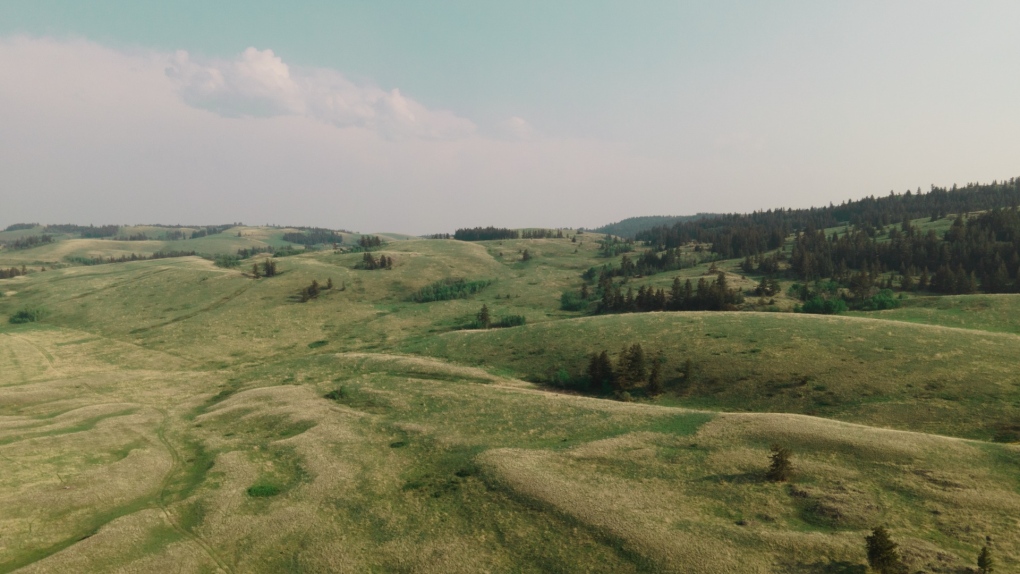Protection coming for large tract of threatened grassland south of Kamloops, B.C.
 (Photo by Fernando Lessa, provided by the Nature Conservancy of Canada)
(Photo by Fernando Lessa, provided by the Nature Conservancy of Canada)
An area of dry, rolling hills in British Columbia's Interior known for its varieties of grasses and home to many of the province's at-risk species is being protected as part of a $54 million conservation project.
The Nature Conservancy of Canada said Wednesday the 60-square-kilometre site south of Kamloops, now known as Bunchgrass Hills, is the result of funding and work of businesses, individuals, foundations and the federal and B.C. governments.
“We're calling this new conservation area Bunchgrass Hills in honour of the many grass species that define and sustain the landscape,” Nancy Newhouse, Nature Conservancy of Canada regional B.C. vice-president, said during a virtual news conference.
“It's not just grasses, Bunchgrass Hills conservation area encompasses the truly impressive mosaic of grassland, wetland and woodland habitat that will now be protected well into the future,” she said.
Among the participants at the news conference was federal Environment Minister Steven Guilbeault, who said the federal government contributed almost $17 million to the project through the Canada Nature Fund.
“It is important to protect these types of landscapes, especially when they are home to endangered species,” he said.
Newhouse said preserving Bunchgrass Hills will secure vital habitat and safe pathways for dozens of species living in the Thompson-Nicola region.
Several of those species are listed as threatened, including the great basin spadefoot toad and great basin gopher snake, as well as the American badger and Lewis's woodpecker, she said.
The grasslands were once part of the 140-year-old Stump Lake Cattle Ranch and will still support sustainable cattle grazing, but the land will be managed for conservation, making Bunchgrass Hills the conservancy's fourth collaboration with conservation-minded ranchers, said Newhouse.
The nature conservancy said in a statement that funding for the protected habitat came from the provincial and federal governments and several private foundations and individuals.
Rolling hills of the grasslands are covered in bluebunch wheat grass and other native grasses, punctuated by Douglas-fir woodlands and scattered wetlands, forming some of the traditional territories of the Secwepemc, Nlaka'pamux and Syilx Indigenous nations.
Prof. Wendy Gardner, a grasslands ecologist at Thompson Rivers University in Kamloops, said B.C.'s grasslands comprise a small part of the province's total land mass but play a large part in the ecosystem.
“B.C. grasslands cover approximately point eight per cent of the province, but they're home to more than 30 per cent of our species at risk, making these areas hugely important for habitat,” she said. “Unfortunately, these nature habitats are facing continued pressure due to a variety of factors.”
Gardner said the greatest loss of grasslands habitat in B.C. is from development, particularly housing.
Danielle Cross, a nature conservancy director, said Bunchgrass Hills is a rare ecosystem that is an essential habitat for wildlife.
It filters water, provides clean air, stores carbon and supports local communities, she said.
This report by The Canadian Press was first published June 28, 2023.
CTVNews.ca Top Stories

Heavy snow, freezing rain warnings hit parts of Canada, expected to last throughout Monday
Significant snowfall and heavy rain hit parts of Canada on Sunday and the weather system is expected to continue into Monday morning and throughout the day.
BoC expected to lower interest rates again, with odds leaning toward larger cut
Financial markets and forecasters are betting on another jumbo interest rate cut from the Bank of Canada this week.
The Canada Post strike involving more than 55,000 has hit 25 days
The Canada Post strike involving more than 55,000 workers has hit 25 days.
Celebrities spotted at Taylor Swift's final Eras Tour performance in Vancouver
Taylor Swift fans from around the world gathered in Vancouver on Sunday to witness the final performance of her massively popular Eras Tour, including a few celebrities.
Government faces third Tory non-confidence vote ahead of potential fiscal hurdle
The Liberals are set to face a third Conservative non-confidence vote today, but the government is likely to survive with the support of the NDP.
U.S. should be concerned about illegal immigration from Canada: Canadian survey
More than 80 per cent of Canadians believe the flow of illegal immigrants from Canada to the U.S. is a concern, according to a new survey.
Jay-Z denies allegations he sexually assaulted a 13-year-old in 2000 with Sean 'Diddy' Combs
A woman who alleges she was sexually assaulted by Sean 'Diddy' Combs has amended her lawsuit to include allegations that she was also assaulted by Jay-Z at the same party.
Taylor Swift ends record-smashing Eras Tour in Vancouver, after glittering global run
Taylor Swift took the stage for the final time on her record-smashing Eras Tour, watched by tens of thousands of delirious fans in Vancouver's BC Place arena and by millions on livestreams around the world.
Syrian prime minister says government is still functioning but foreign and domestic challenges loom
Syria's prime minister said Monday that most cabinet ministers are still working from offices in Damascus after rebels entered the capital over the weekend and overthrew President Bashar Assad. Streams of refugees crossed in from neighboring countries, hoping for a more peaceful future.






























